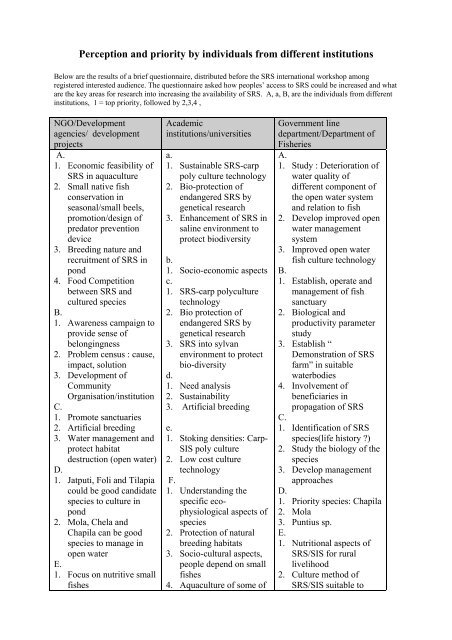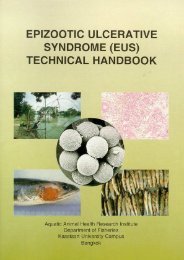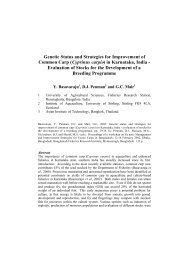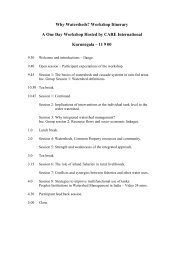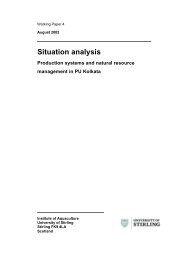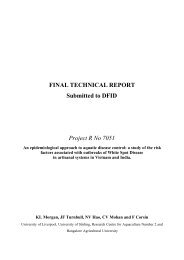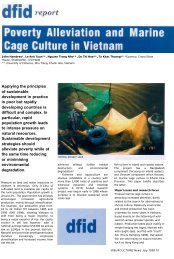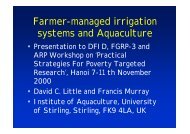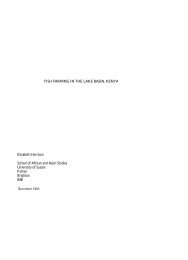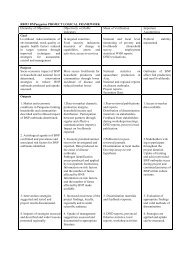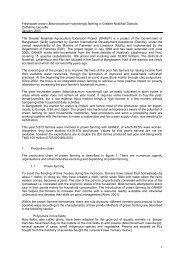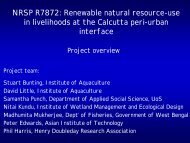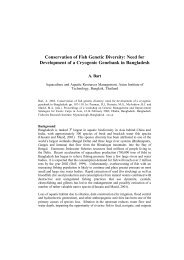Comments from participants - DFID@Stir
Comments from participants - DFID@Stir
Comments from participants - DFID@Stir
- No tags were found...
You also want an ePaper? Increase the reach of your titles
YUMPU automatically turns print PDFs into web optimized ePapers that Google loves.
Perception and priority by individuals <strong>from</strong> different institutionsBelow are the results of a brief questionnaire, distributed before the SRS international workshop amongregistered interested audience. The questionnaire asked how peoples’ access to SRS could be increased and whatare the key areas for research into increasing the availability of SRS. A, a, B, are the individuals <strong>from</strong> differentinstitutions, 1 = top priority, followed by 2,3,4 ,NGO/Developmentagencies/ developmentprojectsA.1. Economic feasibility ofSRS in aquaculture2. Small native fishconservation inseasonal/small beels,promotion/design ofpredator preventiondevice3. Breeding nature andrecruitment of SRS inpond4. Food Competitionbetween SRS andcultured speciesB.1. Awareness campaign toprovide sense ofbelongingness2. Problem census : cause,impact, solution3. Development ofCommunityOrganisation/institutionC.1. Promote sanctuaries2. Artificial breeding3. Water management andprotect habitatdestruction (open water)D.1. Jatputi, Foli and Tilapiacould be good candidatespecies to culture inpond2. Mola, Chela andChapila can be goodspecies to manage inopen waterE.1. Focus on nutritive smallfishesAcademicinstitutions/universitiesa.1. Sustainable SRS-carppoly culture technology2. Bio-protection ofendangered SRS bygenetical research3. Enhancement of SRS insaline environment toprotect biodiversityb.1. Socio-economic aspectsc.1. SRS-carp polyculturetechnology2. Bio protection ofendangered SRS bygenetical research3. SRS into sylvanenvironment to protectbio-diversityd.1. Need analysis2. Sustainability3. Artificial breedinge.1. Stoking densities: Carp-SIS poly culture2. Low cost culturetechnologyF.1. Understanding thespecific ecophysiologicalaspects ofspecies2. Protection of naturalbreeding habitats3. Socio-cultural aspects,people depend on smallfishes4. Aquaculture of some ofGovernment linedepartment/Department ofFisheriesA.1. Study : Deterioration ofwater quality ofdifferent component ofthe open water systemand relation to fish2. Develop improved openwater managementsystem3. Improved open waterfish culture technologyB.1. Establish, operate andmanagement of fishsanctuary2. Biological andproductivity parameterstudy3. Establish “Demonstration of SRSfarm” in suitablewaterbodies4. Involvement ofbeneficiaries inpropagation of SRSC.1. Identification of SRSspecies(life history ?)2. Study the biology of thespecies3. Develop managementapproachesD.1. Priority species: Chapila2. Mola3. Puntius sp.E.1. Nutritional aspects ofSRS/SIS for rurallivelihood2. Culture method ofSRS/SIS suitable to
sustainable catch fordifferent waterbodiesJ.1. Interdepartmentalcollaboration(DAE,Water DevelopmentBoard, Education)2. Improve breedingtechnology3. Protection of naturalaquatic habitatK.1. Develop a database onSRS at local andnational level2. Breeding of extinctspecies3. Awareness building onhealth(nutritional) andenvironment to thecommunityL.1. Establish perennialwater pockets in floodplain areas for naturalbreeding of SRS2. Government FisheriesDepartment, LineMinistries and NGOsclose coordination inwater pocketconservation and forappropriate training3. Links between scientistand beneficiaries incollecting and sharinginformation andinterpretation. Protectthe ecology of wetlands.M.(private org.)1. Identify incomegenerating naturalresources2. Find out best profitableuse of natural resources3. Alternative way toeducate poor people toutilise natural resourcesmaintaining soundecologytechniques for farmersconsumption2. Nutritional aspects/nutrition for all classesof people3. To maintain high energylevel for the poor <strong>from</strong>SRSM.1. Protect endangeredspecies2. Ensure favorable env.For SRS breeding3. Focus those speciesthose have low marketprice(access to poor)N.1. Study life history ofSRS2. Availability of waterbodies and access ofpeople3. Consider SRS polyculture and managementaspects togetherO.1. Consider Poly culturefor farmers consideringconsumption and cashcrops2. 2. Nutritional aspectsfor all classes of people3. 3. High energy level forpoor class people whohave been suffering<strong>from</strong> malnutritionP.1. Improvement of thenatural habitat2. Conservation of biodiversity


